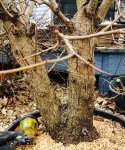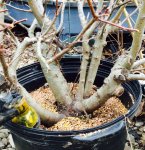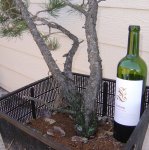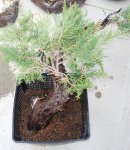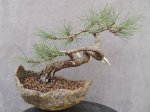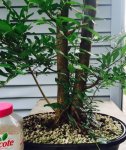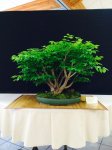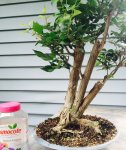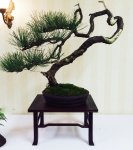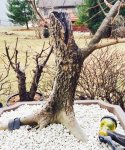I've decided to post a thread on some basic collecting guidelines in hopes of helping others getting started on this rewarding way of getting good material.
I worked at a landscape nursery for almost 4 years. In that time I learned how to be successful at digging trees to put in containers,balling and burlap ping trees and transplanting trees with a large tree spade.
The trees that went into buckets I dug up by hand. I had to be able to transplant a tree from the ground to a bucket with a fair amount of certainty it would live. We guaranteed every tree. Everything I learned there I put to use collecting from wilds.
First let's talk about the tree you collect. You may be the first human to ever see this tree. When you collect it you are taking it from a place in which it has been growing happily it's whole long life. It will be your responsibility to provide a new place in which it can be happy. Remember, it never asked to be ripped out of its home so you owe it this much. This tree owns you as much as you own it. No matter if it stays with you till the end of your days or you sell or give it away you will always know this tree more intimately than any other person. You were the one who collected it. And once you collect a tree it will change the way you think about and look at trees for forever more.
Preparation:
There are a few things you will need in order to successfully collect a tree.
1: A good shovel. I use a long handle pointed shovel you find in any hardware. A folding shovel may sound like a good idea but you need the leverage of a long handled shovel. I also suggest you sharpen it. The shovel can cut through some fairly large roots.
2: Saws. Two of them. One for the trunk. And one for roots. I use a curved blade hand saw for both applications. It rips through roots like crazy. I know some people use rechargeable reciprocating saws like a Sawzall but I like to keep the weight factor to a minimum.
3: Bypass cutters. For roots too. The ones too large to cut with the shovel but not so large you need the saw.
4: A container to put the tree in. Pines need to be brought out with native soil. I recommend balling them up with burlap or what I use,a bed sheet cut to size. Buckets are a bit cheaper to carry any distance so I use them only when I'm close to my vehicle. Balled trees can be put in a backpack.
5: Backpack. It's uses are manyfold. Holds tools and trees.
6:Compass or gps device. You can get lost very easily. Make sure you can get out of the woods. And know where you are in case something happens.
7: First aid kit. Nothing major but you will be using sharp tools and are out in the woods. Your safety is a primary concern. The most wicked yamadori will do you no good if you kill yourself out in the bush.
The Collecting.
So you finally made it to the tree with all of your gear. You're ready to make this future masterpiece yours but where do you start.
I like to clean out all of the dead leaves,grass and whatever else is around the trunk. Leave the growing grass though. It will help keep the rootballs intact. I've dug trees out of sand,gravel,muck and clay. They all present their own problems but the premise is the same with all of them. To get as many roots as possible. Sand and muck are easier. Gravel is tough because you need to work at getting the shovel around the stones. Clay is heavy. The best thing about clay though is it stays together better than the others.
Now is the time to saw the trunk down. It's easier when the tree is anchored in the ground.
You're ready for the actual digging. I place the shovel about 8 to 10 inches out from the trunk. This gives you a root ball from 16 to 20 inches across. Step down on the shovel vigorously. When you run into big roots the shovel will slip sideways. Just keep going around the tree shoving it in in a circle completely around. It will go into the soil between the larger roots cutting smaller ones.
Now move out 6 inches or so. Find the big roots and dig out around them in order to expose them for some sawing. Once you have the big surface roots cut its time to go around the tree again with the shovel. You need to get it all of the way down in the ground up to where you stand on it. Keep going around prying a little inward each time you move the shovel. This helps pack the dirt around the roots. Once all the side roots are cut you may need to cut a tap root. Trees in sand or dry conditions almost always have one. You may need to dig down to it in order to cut the tap root. Sometimes the tree can be tipped up to get at it. One thing to remember is that at no time grasp the trunk. Not to tip the tree or to carry it.
Once the roots are all cut and the tree is free slide the shovel down alongside the root ball and pry it up. Once it is moveable,holding the shovel with one hand,reach down with your free hand and slide it down the opposite side of the root ball. When you can grasp the point of the shovel,lift the tree out of the hole and set it on the cloth you brought to wrap it in. Wrap it tight. Tie it to the trunk with a piece of twine. Be a good person and backfill the hole,gather up your tree and your gear and head out!
Aftercare.
Once you get the tree home you have a few things you need to do.
Pines and junipers go in a bucket with the native soil intact. Water good and place in the shade for at least a week.
Decidious trees should be washed and barerooted. At this time cut back all of the large roots you can get away with. Place in a collander in bonsai soil. I set mine right out in the sun.
I hope this thread helps people successfully do some collecting.

